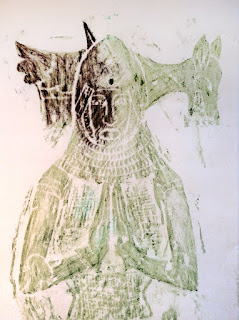Replica brasses were available when the church was used as a museum but went into storage. Fortunately, these have been issued on loan from the Norfolk Museums and Archaeological Service, bringing them back to St Peter Hungate. What good news! I do like it when community organisations work together to support each other.
Replicas are made because abrasion from continually taking rubbings from original brasses would eventually cause irrepairable damage to the soft metal. The datails would eventually be rubbed away leaving the brass looking smoothly polished. Replicas also allows for a collection of brasses from various places. Often they are reduced in scale to half or a third original size.
Rubbings are taken with a hard pigmented wax. The hardness prevents the wax from filling in the carved details. The surface, in relief, 'prints', creating the image which emerges bit by bit. The effect is rather like a black & white photograph in a developing tray - strangely exciting!
This first character is Sir Humphrey Stafford, 1548, from Blatherwyck, Northamptonshire...
Popular with children, rubbings can be done with typical wax crayons, although the quality is low, the result is quick - great for short spans of attention!
The professionals' wax makes for a far better result..!
This character is Sir John de Foxley (Foxle), hence the fox motif behind his head. He dates from 1378, and comes from Bray, Berkshire, England. Here he is in full-length glory..!
I love the black wax. It make a really inky look to the rubbing. However, there are other colours too! Here is one in bronze with touches of gold to add extra shine...
She is Lady Matilda (Maud) de Foxley (Foxle), 1378 of Bray, Berkshire, in England, the first wife of Sir John de Foxley. If you look closely, you see an heraldic lion wrapped around her dress...
Of course, these metallic colours are great on black paper, too. Silver shows up very well.
This fella is Sir George Speke, 1528, Dowlish Wake, Somerset in south-west England. He is shown wearing plate armour, sword and spurs, but without a helmet. (Slightly too large to fit the sheet of paper, he is diagonally across the page.)
Not all brasses are noble men and women in prayer. Some are rather macabre, like this one...
He is a skeleton wrapped in a shroud tied at his feet. He is a state of decay and worms are coming out of his eyes! Here is a closer look...
His name is Ralph Hamsterley, Rector and Fellow of Merton College, Oxford. Oddly, this brass, from Oddington, Oxford, was made in 1510 even though Hamsterley did not die until 1518. Sometimes, these brasses were made in somber readiness for death. How grim!










No comments:
Post a Comment